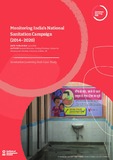Monitoring India’s National Sanitation Campaign (2014–2020)
| dc.contributor.author | Mehrotra, Santosh | |
| dc.coverage.spatial | India | en |
| dc.date.accessioned | 2021-06-25T11:58:34Z | |
| dc.date.available | 2021-06-25T11:58:34Z | |
| dc.date.issued | 2021-06-22 | |
| dc.identifier.citation | Mehrotra, S. (2021) Case Study 2: Monitoring India’s National Sanitation Campaign (2014–2020), The Sanitation Learning Hub, Brighton: IDS, DOI: 10.19088/SLH.2021.011 | en |
| dc.identifier.isbn | 978-1-78118-813-2 | |
| dc.identifier.uri | https://opendocs.ids.ac.uk/opendocs/handle/20.500.12413/16714 | |
| dc.description.abstract | In 2011, India had more phone users (around 54 per cent of households) and television access (33 per cent) in rural areas than people with access to tap water (31 per cent) and toilet facilities (31 per cent), according to Census 2011. This clearly indicates the failure of government programmes to change the centuries-old practice of defecation in the open. This neglect of safe sanitation has had catastrophic outcomes in terms of human well-being. This case study is an analysis of the latest central government Swachch Bharat Mission - Gramin (Clean India Mission - Rural) (or SBM-G), which has achieved much greater success than any hitherto government effort in providing access to and use of toilets, especially in rural areas where the need is greatest. However, any conception of achieving ODF status, or free of open defecation, in a village (or any limited geography) is more than merely building toilets. The Sanitation Learning Hub commissioned case studies of sanitation campaigns in both India and Nepal, drawing out the lessons learnt for other countries wishing to implement similar initiatives. Both case studies focus on how target setting and feedback and reporting mechanisms can be used to increase the quality of campaigns. | en |
| dc.description.sponsorship | Sida | en |
| dc.language.iso | en | en |
| dc.publisher | The Sanitation Learning Hub, Institute of Development Studies | en |
| dc.relation.ispartofseries | Sanitation Learning Hub Case Study;2 | |
| dc.rights | This series is licensed under the Creative Commons Attribution-Non-Commercial-NoDerivs 3.0 Unported License (https://creativecommons.org/licenses/by-nc-nd/3.0/). Attribution: You must attribute the work in the manner specified by the author or licensor. Non-commercial: You may not use this work for commercial purposes No Derivative Works: You may not alter, transfer, or build on this work. Users are welcome to copy, distribute, display, translate or perform this work without written permission. For any reuse or distribution, you must make clear to others the licence terms of this work. If you use the work, we ask that you reference SLH and send a copy of the work or a link to its use online to the following address: The Sanitation Learning Hub, Institute of Development Studies, University of Sussex, Brighton, BN1 9RE (SLH@ids.ac.uk) | en |
| dc.rights.uri | http://creativecommons.org/licenses/by-nc-nd/3.0/ | en |
| dc.subject | Participation | en |
| dc.title | Monitoring India’s National Sanitation Campaign (2014–2020) | en |
| dc.type | Series paper (non-IDS) | en |
| dc.rights.holder | Institute of Development Studies | en |
| dc.identifier.team | Participation | en |
| dc.identifier.doi | 10.19088/SLH.2021.011 | |
| dcterms.dateAccepted | 2021-06-22 | |
| rioxxterms.funder | Default funder | en |
| rioxxterms.identifier.project | The Sanitation Learning Hub | en |
| rioxxterms.version | VoR | en |
| rioxxterms.versionofrecord | 10.19088/SLH.2021.011 | en |
| rioxxterms.funder.project | 5e50f69d-6102-4a66-b12d-49ceb02612b0 | en |
Files in this item
This item appears in the following Collection(s)
Except where otherwise noted, this item's license is described as This series is licensed under the Creative Commons
Attribution-Non-Commercial-NoDerivs 3.0 Unported License
(https://creativecommons.org/licenses/by-nc-nd/3.0/).
Attribution: You must attribute the work in
the manner specified by the author or licensor.
Non-commercial: You may not use this work for commercial
purposes No Derivative Works: You may not alter, transfer,
or build on this work.
Users are welcome to copy, distribute, display, translate
or perform this work without written permission. For any
reuse or distribution, you must make clear to others the
licence terms of this work. If you use the work, we ask
that you reference SLH and send a copy of the work or
a link to its use online to the following address: The
Sanitation Learning Hub, Institute of Development Studies,
University of Sussex, Brighton, BN1 9RE (SLH@ids.ac.uk)


